Cyrix Corporation and Subsidiaries Notes to Consolidated Financial Statements
December 31, 1995
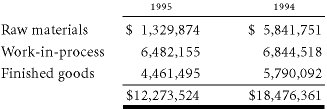
Management estimates the allowance required to state inventory at the lower of cost or market. During the fourth quarter of fiscal 1995, the average selling prices of 486DX2 microprocessors fell below the Company's cost to purchase these products, and the demand for these products declined substantially compared to prior quarters. As the Company does not expect to produce any or generate any significant revenue by selling 486 microprocessors in 1996, the Company wrote off substantially all of its 486 inventory, which exceeded $10 million, during the fourth quarter of fiscal 1995. As product life cycles become shorter and more difficult to predict, and price changes and transitions to new products become more rapid, there is a risk that the Company will forecast demand for its products and market conditions incorrectly and produce excess inventories. Therefore, there can be no assurance that the Company will not produce excess inventories and unexpectedly incur inventory lower of cost or market charges in the future.
The Company has purchased $88 million of wafer fabrication equipment which has been installed in an IBM facility. Management currently anticipates that such equipment has a five year useful life. Intel, the dominant company in the IBM compatible processor market, has a strategy to maintain its competitive advantage through aggressive investments in advanced manufacturing capacity. To remain competitive with Intel, the Company could be required to purchase and transition to more advanced manufacturing equipment before the time period in which its existing wafer fabrication equipment is fully depreciated. If the Company's equipment becomes obsolete as it relates to the manufacture of competitive microprocessors and the Company does not develop an alternative use for such equipment or is not able to sell the equipment for its net book value, the Company would incur a loss related to such equipment.

Management estimates the allowance for uncollectible accounts receivable. The Company performs on-going credit evaluations of its customers and requires advanced payments or secures transactions when deemed necessary. To date, the Company's credit losses have been within management's expectations. However, due to potential consolidation in the personal computer industry and unanticipated changes in the financial condition of the Company's customers, credit losses could exceed management's expectations in the future.
Sales to certain OEM customers and distributors are made under agreements which provide such customers certain rights of return and price protection on unsold merchandise. Management estimates the Company's allowance for returns from and price allowances to be granted to OEM customers and distributors. To date, returns from and price allowances granted to OEM customers and distributors have been within management's expectations. However, there can be no assurance that the Company will not have unanticipated returns or grant unexpected pricing allowances if a product does not perform to expectations, competitors reduce the price of products which are comparable to the Company's products beyond management's expectations, an OEM customer or distributor decides to discontinue its product line which uses Cyrix's products, or other unexpected circumstances occur.
Note: Click the chart to see a larger version. If you wish, you can download the annual report in PDF format.
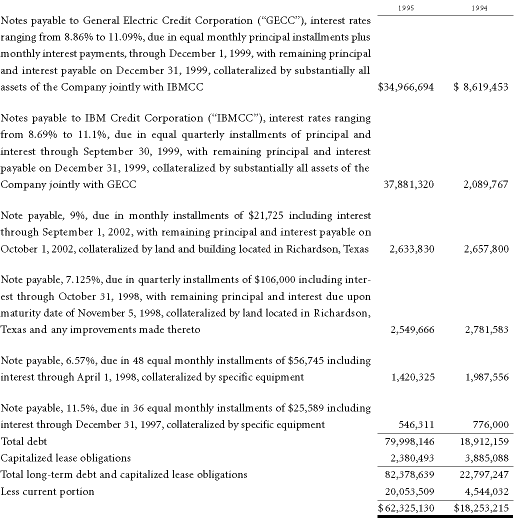
As a result of the Company's financial performance during the fourth quarter of fiscal 1995, the Company failed to comply with certain quarterly restrictive covenants due to its failure to have positive net income and its failure to satisfy certain fixed charge coverage ratios. Each of the Company's creditors waived these defaults for the quarter ended December 31, 1995 and have agreed not to accelerate the maturity of any debt owed at the present time as a result of these defaults. However, certain lenders have declined for the present time to complete the funding of approximately $4 million for equipment purchases, which represents the balance of their commitment to the Company; therefore, the Company intends to fund such remaining equipment purchases from its current cash balances.
In fiscal 1994, the Company signed agreements with IBMCC and GECC ("the equipment lenders") whereby the $88 million capital equipment investment required by the Company's agreement with IBM is being financed under loans which require periodic principal and interest payments and will mature on the earlier of five years from the commencement of each loan or December 31, 1999. The interest rate for each loan is the average of the interest rates for three and five year U.S. Treasury Notes on specified dates plus three hundred twenty-nine basis points. The equipment which is financed by each loan serves as the primary collateral for such loan. In addition, the equipment lenders have a secondary security interest in substantially all of the Company's other assets. The financing agreements contain restrictive covenants which include restriction on dividends, additional debt and certain other transactions and include the maintenance of certain net worth, net income per quarter, working capital and other financial ratios.
The Company has a bank line of credit for up to $37.5 million which expires on January 3, 1997. Availability of the line of credit is subject to borrowing base requirements and compliance with loan covenants and restrictions which are similar to the covenants and restrictions in the equipment financing agreements. Outstanding advances are subject to interest at the Company's option, at either the bank's base rate, payable quarterly, or at 137.5 to 175 basis points over the bank's eurodollar interest rate, payable when each eurodollar advance matures. Collateral for the line of credit includes substantially all of the Company's assets other than the equipment financed by the equipment lenders as described above. Due to the Company's failure to comply with certain financial covenants, no borrowing was available under the line of credit as of December 31, 1995. The Company's line of credit lender issued a waiver of these covenant violations that allows the Company to draw on the line of credit subject to borrowing base requirements and cash flow based borrowing restrictions. There were no borrowings against the credit facility at any time during fiscal 1995.
For each of the next five years and beyond, long-term debt and capital lease obligations are payable as follows:
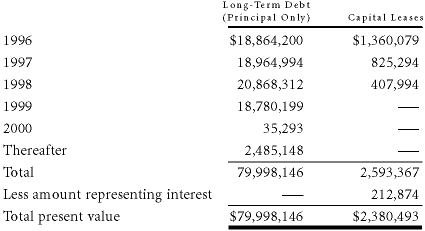
Interest paid by the Company related to its notes payable during 1995, 1994 and 1993 amounted to $6.2 million, $554 thousand and $262 thousand, respectively. Of the total payments under capital leases in fiscal 1995, 1994 and 1993, $244 thousand, $230 thousand and $183 thousand, respectively, represented interest.
Assets under capital lease agreements were as follows at December 31:

The Company leases office space and equipment under operating leases. Total rent expense for the fiscal years ended December 31, 1995, 1994, and 1993, was $2.0 million, $1.2 million and $1.6 million, respectively. Minimum rental commitments under noncancelable operating leases are as follows:
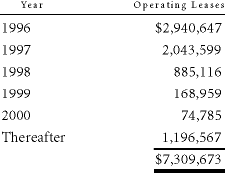

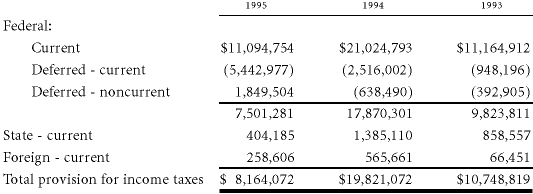
Included in the current tax provisions reflected above are $1.7 million, $1.9 million and $0.6 million for 1995, 1994, and 1993, respectively, of tax benefits related to stock options exercised and disqualifying dispositions recorded as credits to stockholders' equity.
The provision for income taxes reconciles to the amount computed by applying the statutory U.S. federal rate of 35% to income before provision for income taxes as follows:

No provision has been made for income taxes on approximately $2.5 million of cumulative undistributed earnings of certain foreign subsidiaries because it is the Company's intention to permanently reinvest such earnings. If such earnings were distributed, the estimated related taxes due, after giving effect to available tax credits, would be approximately $414 thousand.
The Company made income tax payments of $15.1 million in 1995, $19.6 million in 1994, and $13.2 million in 1993.
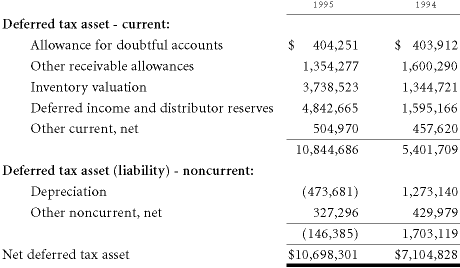
At December 31, 1995 and 1994, no valuation allowance was recorded to offset deferred tax assets.
It is management's expectation that the deferred tax assets will be recoverable through the generation of future taxable income from ordinary and recurring operations. However, if future taxable income is not generated, the majority of the deferred tax assets would be recoverable by a carryback refund of taxes paid in the current or prior years. It is more likely than not that the remainder of the deferred tax assets will be realized.

The shares issued are subject to a repurchase option in favor of the Company of unvested shares upon discontinued employment. Shares issued generally vest over and are fully vested four years from the date of grant. At December 31, 1995, options to purchase 1,251,965 shares were exercisable and 1,139,737 shares were available for future grants.
On January 24, 1994, the United States District Court for the Eastern District of Texas, Sherman Division began to try the Company's allegations that Intel violated certain antitrust statutes and misused its patents and Intel's allegations that the Company infringed certain Intel patents. Effective January 31, 1994, the Company and Intel entered into a settlement agreement which provides for the dismissal of the claims which were to be litigated in the January 24, 1994 trial. Pursuant to the settlement agreement, Intel granted the Company a fully paid-up, irrevocable license under claims 2 and 6 of Intel's United States patent 4,972,338 ("the Crawford patent") and certain other system patents for products sold after January 31, 1994. Intel also acknowledged that products purchased by the Company from certain licensees exhaust Intel device claims including claim 1 of the Crawford patent. Further, Intel paid $5 million to the Company. The Company and Intel agreed that if the January 21, 1994 ruling, insofar as it relates to SGS, was reversed after final adjudication or was remanded for additional findings and subsequently reversed so that Cyrix did not have a right to use claims 2 and 6 of the Crawford patent based on the SGS license, Cyrix would return the $5 million plus interest to Intel. Cyrix deferred recognition as income of the $5 million settlement payment received in February 1994 until final resolution of this issue. Intel agreed to pay the Company an additional $5 million if the January 21, 1994 SGS ruling was upheld after final adjudication. As noted previously, in December 1994, the Court of Appeals for the Federal Circuit upheld the district court's January 21, 1994 ruling and later denied Intel's motion for a rehearing en banc. The time period during which Intel had the right to appeal the case to the United States Supreme Court expired without such appeal, and the Company received the additional $5 million settlement payment in the second quarter of 1995. Therefore, the Company recognized settlement income of $10 million in the second quarter of 1995.
As part of the settlement agreement, the Company and Intel agreed to litigate in the United States District Court for the Eastern District of Texas, Sherman Division, whether products manufactured by SGS affiliates under the "have-made" provision in the SGS-Intel license, sold to SGS, and then sold to the Company fall within the scope of the SGS license. On December 30, 1994, the district court ruled that SGS was licensed by Intel to exercise have-made rights by having third parties (including SGS affiliates) manufacture and sell microprocessors to Cyrix free of claims of patent infringement by Intel. Intel appealed the ruling on March 7, 1995. If the Company wins this licensing issue after all appeals have been exhausted, Intel will pay the Company $1 million. If Intel wins this licensing issue after final adjudication, the Company will pay Intel $1 million. The Company will have no liability to Intel for products manufactured by SGS affiliates prior to August 31, 1994, other than the potential $1 million payment, and will only have liability, if any, for products manufactured by SGS affiliates after August 31, 1994.
Similarly, the Company and Intel agreed to litigate in the United States District Court for the Eastern District of Texas, Sherman Division, whether IBM is licensed under claim 1 of the Crawford patent when manufacturing products that are primarily designed by the Company. On April 5, 1994, the district court granted IBM's motion to intervene, and on December 8, 1994, the district court ruled that IBM was licensed by Intel to act as a semiconductor foundry for Cyrix free of claims of patent infringement by Intel. Intel appealed the ruling on March 7, 1995. If the Company wins this licensing issue after final adjudication, Intel will pay the Company $1 million. If Intel wins this licensing issue after final adjudication, the Company will pay Intel $1 million. The Company will have no liability for products manufactured by IBM prior to January 31, 1994, other than the potential $1 million payment, and will only have liability, if any, for products manufactured by IBM after January 31, 1994.
In June 1995, all of the actions were consolidated into one complaint in the federal district court in Dallas, Texas. The Company intends to defend the complaint vigorously. The Company moved to dismiss the consolidated amended class action complaint in July 1995. The ultimate outcome of the stockholders class action cannot presently be determined. A decision adverse to the Company in this matter could have a material adverse effect on the Company, its financial condition, its results of operations and its future prospects.
Note: Click the chart to see a larger version. If you wish, you can download the annual report in PDF format.
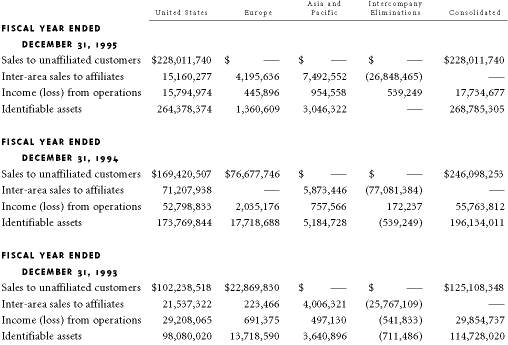
Gross export sales to unaffiliated customers in Asia and the Pacific region by domestic operations in fiscal years 1995, 1994 and 1993 were $100 million, $53.8 million and $35.4 million, respectively. Also, gross export sales to unaffiliated customers in Europe by domestic operations in fiscal year 1995 were $44.1 million.
Cash and Cash Equivalents. The carrying amount approximates fair value.
Investments. The carrying amount approximates fair value because of the short maturity and nature of these instruments. The Company places its cash investments only in high credit quality financial instruments and limits the amount invested in any one institution or in any type of instrument. The Company has not experienced any significant losses on its investments.
Accounts Receivable. The carrying amount, which is net of valuation allowances for credit losses and returns from and price allowances to be granted to certain OEM customers, approximates fair value.
One customer, AST, accounted for approximately 11% of Cyrix's sales in fiscal 1995. The loss of such customer, if not replaced by other OEM customers with similar sales volumes, could have a material adverse effect on the Company's results of operations.
Accounts Payable. The carrying amount approximates fair value because of the short-term nature of these instruments.
Long-Term Debt and Capitalized Lease Obligations, Including Current Maturities. Of the Company's $82.4 million in long-term debt and capitalized lease obligations, approximately $64.1 million was borrowed in fiscal 1995 and remains outstanding at December 31, 1995. As the majority of the debt was incurred in 1995, the carrying amounts approximate fair value. The carrying amounts of long-term debt and capitalized lease obligations related to borrowings prior to fiscal 1995 do not differ materially from their fair values estimated using discounted future cash flows analysis and rates currently available for debt of similar terms and maturity.
The Company's manufacturing strategy is to develop relationships with qualified semiconductor manufacturers which offer leading CMOS process technologies. The Company has focused its resources on product design, market development and customer support, rather than on developing process technologies and operating manufacturing facilities. Instead, the Company relies upon third parties to manufacture and assemble its products. The Company's reliance on third-party manufacturers causes several material risks, including the possible unavailability of or delays in obtaining access to certain process technologies, the absence of controllable product delivery schedules, manufacturing yields and production costs and the possible breakdown in the relationship with the third-party manufacturers. Any significant delay or production cost problem brought about by these risks could have a severe impact on the Company. For example, production of the 6x86 products is expected to ramp in the first quarter of fiscal 1996 at IBM and the third quarter of 1996 at SGS if SGS is capable of manufacturing that product with acceptable performance and cost. The Company's financial performance during fiscal 1996 will be dependent upon numerous factors including a successful transition from entry level microprocessors to the Company's 6x86 microprocessors, on-going performance enhancements to the 6x86 microprocessor design to remain competitive with the leading performance processors in the market, improved manufacturing yields by IBM, successful qualification of the SGS manufacturing process during the first half of fiscal 1996 and production ramp during the latter half of 1996, pricing conditions, obtaining design wins from manufacturers of personal computers and other factors. There can be no assurance that the Company and its suppliers can successfully supply 6x86 products with competitive performance and cost in commercial volumes during 1996. In addition, there can be no assurances that manufacturers of personal computers will design the 6x86 product into their computers or purchase such products in volumes and at prices that will enable Cyrix to maintain or increase revenues and profits. Further, Cyrix competitors could introduce more advanced or lower priced products that shorten the life cycle of, or the demand for, such 6x86 products which in turn could have a severe impact on the Company's future performance.
From time to time, Cyrix has been notified that it may infringe intellectual property rights of others. If any such claims are asserted against the Company, the Company may seek to obtain a license under the third-party's intellectual property rights. The Company could decide, however, to resort to litigation to challenge such claims. Such challenges could be extremely expensive and time consuming and could materially adversely affect the Company's business, financial condition and results of operations. No assurance can be given that all necessary licenses can be obtained on reasonable terms nor that litigation can be avoided. The Company's inability to obtain licenses on favorable terms or avoid litigation related to such licenses could have a severe impact on the future operations of the Company.